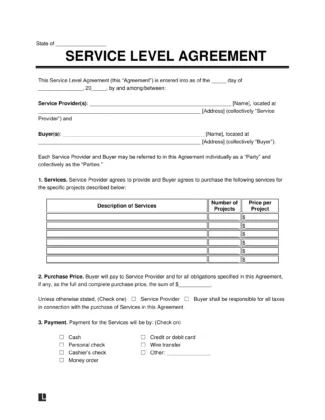
Use an SLA to outline a service provider’s level of service and manage customer expectations.

Updated August 12, 2024
Written by Sara Hostelley | Reviewed by Brooke Davis
A service level agreement defines the level of services a provider commits to achieving for their client or customer. It defines standards and establishes consistency in relationships with different customers.
A service agreement is broader than an SLA, as it explains the terms and conditions between the provider and client. It covers various aspects, such as the agreement’s duration, payment terms, intellectual property rights, and other factors. An SLA contains more measurable and specific terms relating to the quality and level of service.
A service level agreement (SLA) outlines the obligations of a service provider and their client to one another. It contains critical details about the service and the minimum quality of service the parties agree upon. SLAs are most prevalent in industries emphasizing the reliability, performance, and quality of the provided services, such as the IT, outsourcing, and healthcare service industries.
All service providers should use an SLA with their customers. Service level agreements provide important promises and protections like:
YES, a service-level agreement is legally binding. When the service provider and client properly draft and execute it, it becomes a legal contract between the parties. It protects your legal rights no matter which party you are in the agreement.
Explore the most common types of SLAs:
Internal SLAs describe the services that departments within the same company will provide one another. For example, a company’s sales and marketing departments may establish an internal SLA to increase lead quality or optimize the performance of marketing campaigns.
On the other hand, an external SLA is between an external client and a service provider.
Explain the services that the service provider will perform for the client. If it’s an internal SLA, clarify the relationship between the two internal departments within a company.
Specify the scope of the services, including any limitations and exclusions. Clarify what the provider includes and excludes in their service offerings.
Describe the desired outcomes and objectives that you hope the provided services will achieve. List the targets, quality measures, performance standards, and customer service standards the provider should meet when delivering their services.
Think about what you want the service levels to measure, such as the responsiveness, reliability, and quality of the services being provided. Some common service levels an SLA may document include the following:
Once you document the level of service you want to measure, you can set specific performance metrics. Refer to industry standards for metrics and key performance indicators (KPIs). You can set these at or above industry standards, depending on the service provider’s expected capabilities.
Establish the acceptable thresholds and minimum/maximum rates. This way, the service provider has a range they can aim for.
Explain both parties’ obligations and responsibilities. Outline each party’s tasks, roles, and contributions to ensure the service provider can successfully deliver their services. For example, the service provider may require the client to supply the necessary facilities, equipment, or infrastructure.
Clarify how the service provider will report their progress and metrics. Establish a desired frequency. For example, the service provider may provide a weekly update with basic metrics and a monthly report with a broader overview of the progress of their service provision.
You must define the escalation procedures, which involve handling issues or conflicts that arise from the agreement. These procedures help you address the problem timely and escalate the issue to the appropriate level of supervision when necessary. Include the following elements in your escalation procedures:
The SLA states that the client must provide service consistent with the document’s terms. However, circumstances may cause the provider to fall short of their service expectations.
The SLA should detail what happens in these cases. For example, the SLA may state that the customer receives a service credit they can use later. If you include provisions for service credits, please specify the nature and amount of compensation. The agreement may also specify penalties the service provider must pay if they fail to deliver their services as promised.
Include standard legal terms and conditions that dictate the agreement, such as the following:
Create a process for reviewing and revising the SLA. Once both parties are satisfied with the terms, they can approve and sign it. Please collect feedback and input from all stakeholders before finalizing your agreement.
Here are some additional considerations for your SLA to make it even more robust and beneficial for all parties involved: